| Truth in Media Global Watch
Bulletins |
|

June 16, 2002 |
Bob's "Irish" Roots |

 Bob Djurdjevic
Bob Djurdjevic
brilliant editor of
Truth In Media wrote this fascinating piece on his trip
to Eire. Originally having circulated these remarkable photos to friends,
Bob generously agreed to share same with FP for the St Pat's Edition.
An outspoken critic of the unprovoked attack on Yugoslavia by
the insidious Bill Clinton,Bob took to the internet to campaign against
Clinton's war.
Bob's prodiginious writings have appeared in the Establishment Press.
|
God must have intended me to be
Irish.
I arrived in North America on
March 17, 1970 - St. Patrick's Day. And was totally clueless about why the
immigration and customs officials were so happy and relaxed. Everybody
seemed to be having a good time.
"What a country!" I thought in
amazement. "I wonder if they are like that all the time?"
Little did I know, of course, that
the "happy hour" at the airport was due to ample quantities of Guinness or
Jamieson's that the officials must have consumed.
Over the years, I've made many
Irish friends. And have found them to be quite similar to the Serbs in
almost every respect except the language and the
religion.
Both nations have been oppressed
by various empires through the centuries. Both have resisted it violently,
until they did win their freedom. And both are capable of going from
despair to laughter in a second.
When I traveled through that country, both during the NATO bombing and later on,
after I had visited bombed-out sites and given speeches and interviews to the
media, I had been met with nothing but kindness by the ordinary folks in the
streets despite my American passport.
And people were singing and dancing as if the 79-day bombing never
happened.
As an Irish friend of mine once told me in London, where he is a
producer and a screenwriter for the BBC TV network, "I love the Serbs. They talk too much, they sing too much,
they drink too much... they are so - IRISH!"
Another Irish friend (from
Chicago, a retired university professor of linguistics), claims that, "the Serbs
are the easternmost Irish, and the Irish are the westernmost Serbs" (because of
some ancient Celtic connection).
Two years ago, this friend and I went to Ireland
together. He, as my "tour guide;" I, as a first-time visitor. We had a
ball touring all over this small island in our rental car!
Once in Belfast I played my Irish (republican)
rebel songs CD on my computer laptop in our hotel room.
Belfast, as you know, is still British territory. My friend was
at first startled and a little scared, but then he laughed and joined me in
humming along.
Afterwards, I even wrote a short story about our
subsequent Belfast experiences, crossing the war zone lines between the
Protestants and the Catholics with a help of a local cab driver (see the "War of the
Hooligans" which also contains some photos I took).
As for this photo of yours truly, taken somewhere
in western Ireland, south of Galway...

But don't get your hopes up, ladies. The
kind of "stud laying" this Irish sign was referring to was that of the pavement
road markers. Which the Irish call "studs."
"May the road rise up to meet you, and the wind be
always at your back," as the Irish say.
Nollaig Shona!
|
Bob's photos
from...
Ireland...

Photos taken by Bob O'Dj.
and Prof. Peter Maher
("Pero") |
Bob's & Pero's Tour of
Ireland (1998)

I flew into Dublin from Paris. I left Ireland from
Shannon. So if you follow the numbers on the above map (from 1 to
13), you will see the order and the approximate route of our
tour.
Dublin...

This is the city's "main drag." The statue is that
of Daniel O'Connell, "The Liberator," who got the anti-Catholic laws
repealed - "Emancipation."

Trinity College

Who has not heard of Molly Malone, "the Tart with the
Cart?" And there she is... still selling her mussels and other favors...
:-)

"The Floozy in the Jacuzzi" happened to be drying off
when we saw her. Normally, water flows right over her. And
yes, sadly, there is a McDonald's even on Dublin's historic
O'Connell Street.

"Historic," in part, because not far from the "Floozy in
the Jacuzzi" is the Post Office on O'Connell Street where the famous
Easter Rising took place in 1916. This is the photo of a painting
at the Post Office that Pero took.
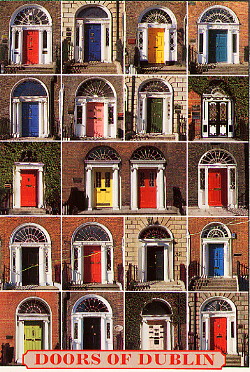
The renowned, colorful Dublin doors...

A cute sign...
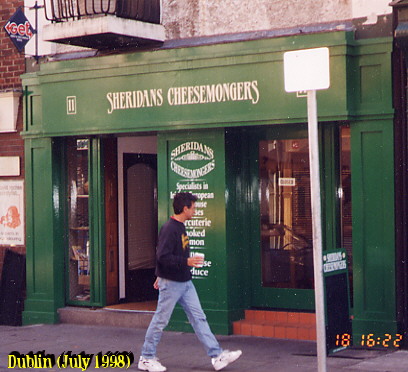
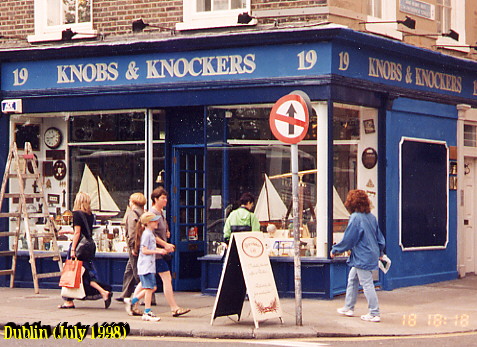
...and some cute Dublin shops
|
Countryside...

:-)

No. 2 on the map: The
red car with its trunk open was our rental jalopy.

No. 3: Glendalough was
the first of many ancient settlements we had visited. This one dates
back to about the 12th century, if my memory serves me right.


No. 5: The Rock of
Cashel

As you can see, the Irish have an entirely different
concept of stud laying... :-)

No. 8: The magnificent
Cliffs of Moher

No. 9: A young rider
near Galway...
Northern Ireland
Countryside...

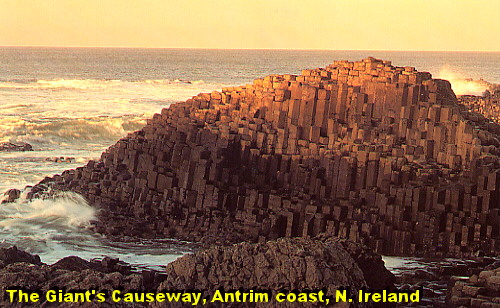
Drogheda

No. 11: Cute town south
of Belfast, just inside the Republic

 
Two young lassies teaching me to accompany them on their
flutes with the "bodhran"

Horsing around with the huge Muiredach's
Cross n Monasterboice, County Louth, near Drogheda, inside an
ancient cemetery. As Pero reminded me, "spanning" the
cross is supposed to be good luck to one who manages
it. Hope my "luck of the Irish" is still holding up...
:-)
Limerick


No. 12: Cute road
tunnels...
|
|
|

TiM Bulletin 98/7-6
July 27, 1998 |
Protestant and Catholic Combatants' Actions Disgrace
the National Flags
Northern Ireland: War of
Hooligans
Rival Gangland Warfare in Belfast
Resembles That of America's Urban
Jungles |
FROM BELFAST, NORTHERN IRELAND
Topic: WESTERN
EUROPE AFFAIRS
BELFAST, Northern Ireland - A bomb blast shook a house in downtown
Belfast rattling and shattering some windows, just as a family of a
Protestant father and a Catholic mother sat down to dinner. The matron of
the family, not of the best of hearing, said: "Was that someone at the
door?" Everybody around the table laughed.
In another instance, a car bomb destroyed the facade of a department
store and damaged several cars in a busy Belfast shopping district. As
soon as the police cordoned off the damaged area, the shoppers continued
their exploits as if nothing had happened.
"Did you know that your hotel is the most bombed out hotel in all of
Europe?," a Belfast cab driver (let's call him Peter), asked this writer
and his traveling companion. This time, the American tourists laughed.
"That's nothing!" I said, visualizing in my own mind Dustin
Hoffman in the "Wag the Dog" movie (which is playing
in Belfast right now). "We have traveled all over Bosnia during the war.
Did you know that Bosnia was the most bombed out place in Europe since
World War II?" This time, Peter laughed.
 Laughter in the face of danger. Not a nervous
laughter. A hearty one. To go with the heartache of life in a war zone.
Such apparently lackadaisical reactions are typical when real life becomes
too grotesque for the normal human senses to process it. Such as in
wartime. Or in urban warfare. That's when humor steps in as man's
self-defense mechanism against fear or despair.
Laughter in the face of danger. Not a nervous
laughter. A hearty one. To go with the heartache of life in a war zone.
Such apparently lackadaisical reactions are typical when real life becomes
too grotesque for the normal human senses to process it. Such as in
wartime. Or in urban warfare. That's when humor steps in as man's
self-defense mechanism against fear or despair.
"Do you see that yellow building to the right; the one which looks like
a cube?," I asked Peter in a role reversal.
"Yes, I do," he replied. "That's the hospital where my kids were
born."
"Well, that building looks exactly like the Holiday Inn in Sarajevo -
the place where the world media had huddled during the shelling of the
city."
"And the place from which the Muslim snipers and mortars fired to
attract the Serb artillery return fire, so the media would depict the
Serbs as the 'aggressors'," interjected this writer's companion, an
Irish-American from Chicago.
By now, it was evident that Peter, our driver, was having a good time.
"Like Sarajevo, huh?" he said with a smirk on his face, as if I had just
complimented Belfast. He turned off the taxi meter, as if implying that
the ride was "on the house."
 Peter then proceeded to drive us through the various Belfast
combatant Protestant and Catholic neighborhoods, showing us the
demarcation lines. Shankill Road, and the area to the north of it, is the
Protestant stronghold. Falls Road to the south is where the Catholics
rule. At some places, the lines of demarcation are so close that you could
throw a rock from one sector to the other.
Peter then proceeded to drive us through the various Belfast
combatant Protestant and Catholic neighborhoods, showing us the
demarcation lines. Shankill Road, and the area to the north of it, is the
Protestant stronghold. Falls Road to the south is where the Catholics
rule. At some places, the lines of demarcation are so close that you could
throw a rock from one sector to the other.
Peter kept explaining where bomb blasts or terrorist actions took place
in the recent past. We also took tons of pictures of the various
"battlefield" insignia and the graffiti which both warring sides use. But
for these Irish sectarian images and an absence of black faces, this part
of Belfast could have been New York's South Bronx, or Los Angeles' Watts.
Yes, replete with the garbage in the streets and boarded up "tenement"
buildings, too.
The police stations in this part of Belfast are like no other this
writer has seen anywhere in his world travels. In both Protestant and
Catholic neighborhoods, they look worse than even the medieval fortresses.
At least the latter had windows, however "slitty." These Belfast police
stations have none. They are surrounded by concrete block barriers in
front of the fortress-like walls, and with a thick protective wire. The
only thing missing was a mote.
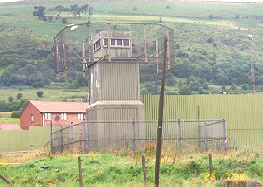 Oh yes, there
are also gun towers at each corner. Think of WW II German prisoner of war
camps. Except that in the case of the Belfast police stations, with the
police are also the prisoners.
Oh yes, there
are also gun towers at each corner. Think of WW II German prisoner of war
camps. Except that in the case of the Belfast police stations, with the
police are also the prisoners.
TiM's bottom line? Belfast is not at all like the war in Bosnia, for
example, which is what some people had compared it to. Despite all the
atrocities, the Bosnian war was a relatively noble struggle of three
different peoples' for independence or sovereignty.
Maybe once upon a time, the Northern Ireland conflict was also a
righteous rebellion. No longer. Now it seems to be a war of the hooligans,
no different than the gangland wars in American urban jungles. It's just
that these (Protestant and Catholic) thugs wear (and, thereby, disgrace)
the national colors of Ireland and England (i.e., Ulster), while the
American thugs murder people under some home-grown symbols.
But there seems to be one similarity with the Balkan wars. As my
Irish-American companion noted, just as with the American gangland wars,
the Irish civil war is fueled by drug or NWO money which flows in from the
top of the hierarchies, while the poor sods in Belfast, like the destitute
blacks in the American cities, blow each others' brains or knees out.
"If at least they could spell as well as they kill!," Peter, our
driver, said at one stage in mocked exasperation - another example of a
war zone "black humor." The graffiti to which he was reacting,
spray-painted on a wall in the Protestant district of Belfast
read:
"F... IRA. Kill All Tags." (The "Taigs" - is a derogatory term
for the Catholics; kind of like saying the "Kill All Niggers" in the
U.S.).
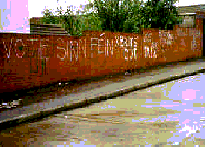 In the
Catholic Falls area, on the other hand, a sign read: "Vote Sinn Fein
x Britts Out!"
In the
Catholic Falls area, on the other hand, a sign read: "Vote Sinn Fein
x Britts Out!"
This weekend alone, there were two gangland-style shootings in
Northern Ireland. In one instance, a Protestant playing cards with his
buddies in Belfast, was shot three times in the legs after an argument.
The victim's legs were bound, and he was left to bleed to death.
In another instance (in Derry), two Catholic brothers (Frankie and
Anthony Creane) were also shot in the legs, allegedly by the Ulster
loyalists. Frankie was shot in the knee; Anthony in the upper leg and the
groin. The latter is right now in critical condition at the Royal Victoria
Hospital in Belfast, to which he was flown from Derry..
"Thanks to its experience with the urban warfare wounds, the Royal
Victoria Hospital has become quite famous," Peter explained, as we drove
past it. "Nowadays, they bring to it the trauma victims from all
over."
I couldn't quite make out if this was a case of fame or infamy. "Looks
like the hospital itself has taken a few hits," I said, pointing to some
small caliber artillery pock-marks under the windows.
This time, nobody laughed. Even three hardened witnesses to human
cruelty in our cab. Nor did my Irish-American companion seem to be anymore
up to pointing out that the Sarajevo Muslims, for example, had also set up
mortar batteries around the Kosevo hospital (see the book "Peacekeeper,"
by the Canadian Gen. Lewis MacKenzie), so as to attract the Serb counter
artillery fire. And so that the "whole world" would then condemn the Serbs
on a CNN/ABC cue. For RETURNING fire!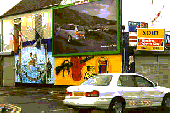
Back in the Protestant part of Belfast, a Nissan billboard ad was
competing with a couple of spirited murals on a wall underneath. "Wonder
if this Protestant battalion represents Nissan's overseas division?" I
joked. This time, everybody laughed again. "Do you suppose there is also a
Toyota overseas rep in the Falls?" (the Catholic neighborhood), I went on.
By now, Peter was laughing so hard the whole cab was shaking.
---
Some of the above photos were taken by Prof. J.P. Maher of Chicago, TiM
editor's traveling companion.

Also, check out... "The Coming
EU-US Clash?", "Northern
Ireland: A War of the Hooligans", "U.S. European
Policy Destroying Own Creations", "Austrian Men
Do Dishes; Shakespeare Condemned in Arizona", "US Senate
Picks Up the NATO Hot Potato", "Russia
Is Still the Bogey No. 1"
Or Djurdjevic's CHRONICLES and WASHINGTON TIMES columns: "A
Bear in Sheep's Clothing", and "Rekindling
NATO to Fuel Cold War..."
































 Laughter in the face of danger. Not a nervous
laughter. A hearty one. To go with the heartache of life in a war zone.
Such apparently lackadaisical reactions are typical when real life becomes
too grotesque for the normal human senses to process it. Such as in
wartime. Or in urban warfare. That's when humor steps in as man's
self-defense mechanism against fear or despair.
Laughter in the face of danger. Not a nervous
laughter. A hearty one. To go with the heartache of life in a war zone.
Such apparently lackadaisical reactions are typical when real life becomes
too grotesque for the normal human senses to process it. Such as in
wartime. Or in urban warfare. That's when humor steps in as man's
self-defense mechanism against fear or despair. Peter then proceeded to drive us through the various Belfast
combatant Protestant and Catholic neighborhoods, showing us the
demarcation lines. Shankill Road, and the area to the north of it, is the
Protestant stronghold. Falls Road to the south is where the Catholics
rule. At some places, the lines of demarcation are so close that you could
throw a rock from one sector to the other.
Peter then proceeded to drive us through the various Belfast
combatant Protestant and Catholic neighborhoods, showing us the
demarcation lines. Shankill Road, and the area to the north of it, is the
Protestant stronghold. Falls Road to the south is where the Catholics
rule. At some places, the lines of demarcation are so close that you could
throw a rock from one sector to the other. Oh yes, there
are also gun towers at each corner. Think of WW II German prisoner of war
camps. Except that in the case of the Belfast police stations, with the
police are also the prisoners.
Oh yes, there
are also gun towers at each corner. Think of WW II German prisoner of war
camps. Except that in the case of the Belfast police stations, with the
police are also the prisoners.
 In the
Catholic Falls area, on the other hand, a sign read: "Vote Sinn Fein
x Britts Out!"
In the
Catholic Falls area, on the other hand, a sign read: "Vote Sinn Fein
x Britts Out!"